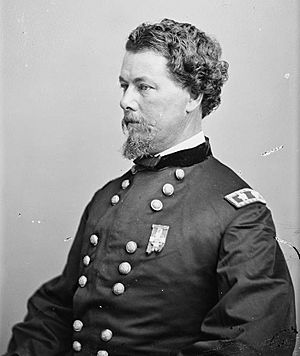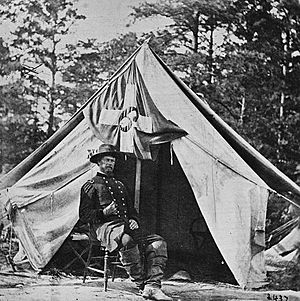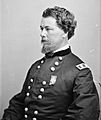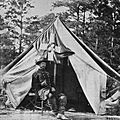Horatio Wright facts for kids
Quick facts for kids
Horatio Gouverneur Wright
|
|
|---|---|

Horatio G. Wright
|
|
| Born | March 6, 1820 Clinton, Connecticut |
| Died | July 2, 1899 (aged 79) Washington, D.C. |
| Place of burial | |
| Allegiance | |
| Service/ |
|
| Years of service | 1841–1884 |
| Rank | |
| Commands held | Department of the Ohio Army of the Ohio VI Corps U.S. Army Corps of Engineers |
| Battles/wars | American Civil War |
Horatio Gouverneur Wright (born March 6, 1820 – died July 2, 1899) was an important engineer and general for the Union Army during the American Civil War. He became the leader of the VI Corps in May 1864. This happened after General John Sedgwick passed away. Wright helped build strong defenses around Washington, D.C.. He also led the first soldiers to break through the Confederate lines at Petersburg. After the war, he worked on big engineering projects. These included the famous Brooklyn Bridge and finishing the Washington Monument. He also became the head of the U.S. Army Corps of Engineers.
Contents
Early Life and Education
Horatio Wright was born in Clinton, Connecticut. His parents were Edward and Nancy Wright. When he was 14, he went to a military school in Vermont. This school is now called Norwich University.
In 1837, he joined West Point. He was a very good student. In 1841, he graduated second in his class of 52 students. He became an engineer in the army. For several years, he taught engineering and French at West Point.
Engineering Work Before the War
In 1846, Wright moved to Florida. He spent ten years working on the harbor of St. Augustine. He also worked on defenses for Key West. This included building Fort Jefferson.
In 1855, he was promoted to captain. He helped the Chief of Engineers, Colonel Joseph Gilbert Totten. Wright also joined a special committee. This group studied how to make strong iron parts for naval guns. He later helped write a report about this work.
Civil War Service
When the Civil War began, Wright was involved in a big event. On April 20, 1861, he helped empty and destroy the Gosport Navy Yard. This was done to stop Confederate forces from using it. He was captured during this action. But he was set free just four days later.
Wright then started building forts around Washington, D.C.. These forts were important for protecting the capital city.
Early Commands
In July 1861, Wright served as Chief Engineer at the First Battle of Bull Run. He was promoted to major in August. The next month, he became a brigadier general. He was sent to South Carolina in November 1861. There, he helped lead an expedition against Port Royal.
From February to June 1862, Wright led Union troops in Florida. He had success in operations against Jacksonville and St. Augustine. Because of his success, he was made a major general in August 1862. He then commanded the Department of the Ohio. In March 1863, he led the new Army of the Ohio. He played a key role in stopping Confederate General Braxton Bragg's invasion of Kentucky in 1862.
However, his promotion to major general was not fully approved. So, it was taken back in March 1863. He went back to being a brigadier general. He briefly commanded a district in Kentucky. Then, he returned to the East.
Leading the VI Corps
In May 1863, Wright was given command of the 1st Division in the VI Corps. This corps was part of the Army of the Potomac. His first major battle in this role was Gettysburg in July 1863. His corps was kept in reserve during this battle.
The corps fought at Mine Run in November 1863. They also saw action at the Battle of the Wilderness in May 1864. On May 9, General John Sedgwick died at Spotsylvania Court House. Wright then took command of the VI Corps. He was promoted to major general again. This time, the promotion was approved.
Wright's corps fought at Battle of Cold Harbor in June 1864. During the Valley Campaigns of 1864, he was sent to Washington, D.C. He had to defend the city from a Confederate attack led by Jubal Early. This happened on July 11 and 12, 1864. Wright commanded the Washington Emergency Defense Force.
During the defense of Fort Stevens, something famous happened. Wright invited President Abraham Lincoln to stand with him on a wall. This wall was exposed to enemy fire. Wright himself later said he was the one who told the president to get to safety.
Wright led the VI Corps again during General Philip H. Sheridan's Shenandoah Valley campaign. This was from August to October 1864. Wright directed the fighting at Battle of Cedar Creek on October 19.
Breaking Through at Petersburg
In the Siege of Petersburg, Wright's VI Corps was the first unit to break through the Confederate defenses. This happened on April 2, 1865. After this, his corps helped defeat Confederate forces at Sayler's Creek on April 6, 1865. Many Confederate soldiers were captured there. This included important generals like Richard S. Ewell. For his brave actions at Petersburg, Wright was honored with another promotion in the regular army.
After the War

After the war, during the time of Reconstruction, Wright commanded the Army of Texas. This was from July 1865 to August 1866. He was promoted to lieutenant colonel of engineers in November. He left volunteer service in September 1866.
Wright then worked on many important engineering projects. These included the famous Brooklyn Bridge in New York. He also oversaw the completion of the Washington Monument in Washington, D.C. In March 1879, he became a colonel. In June 1879, he was named the Chief of Engineers. He retired from the army on March 6, 1884.
He lived in Washington, D.C., until he passed away in 1899. He was buried at Arlington National Cemetery in Arlington, Virginia. His grave has a tall stone monument. It was put there by veterans of the VI Corps. It faces the Washington Monument, which he helped finish.
Places Named After Wright
The city of Fort Wright, Kentucky, is named after Horatio Wright. It was named for an earthwork (a type of fort made of earth) that was planned during the Civil War. This fort was never fully built. It was later removed in the 1880s for road construction.
Fort H. G. Wright is another place named in his honor. It is located on the western tip of Fishers Island, New York.
Images for kids





